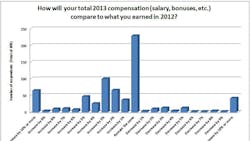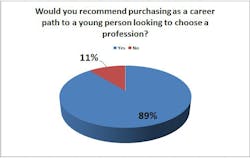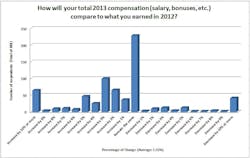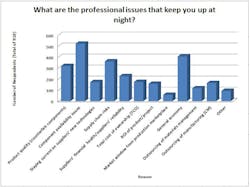Purchasing Pros See Nominal Pay Increase
This file type includes high resolution graphics and schematics when applicapable.
The slow economic recovery is hitting purchasing professionals in the paycheck, according to the results of Global Purchasing’s first annual Salary Survey, conducted late in 2013. We surveyed purchasing executives, managers, and buyers, and found that most expected their total compensation to rise just 1.5% in 2013 compared to 2012.
Despite the nominal pay increase, nearly 60% of those surveyed say they feel their companies adequately compensate them for their work. And most would recommend the purchasing profession to young people entering the workforce. Those that say they are underpaid note that an average increase of 18% would bring their salary to the right level.
Related Articles
- Outsourcing drives need for supply chain expertise
- The real value of purchasing management
- Buyers should leverage distributor capabilities
The Global Purchasing Salary Survey asked a range of pay and career-related questions, including details on salaries and bonuses as well as workforce trends and challenges. Here’s a look at some of the findings*:
The “Typical” Purchasing Professional
The typical purchasing professional responding to our survey is a man (67% of respondents were men; 33% women), 49 years old, with an average of 17 years in the business. He has worked for his current employer for about 12 years, has an associates’ degree or higher, and earns an average $83,000 a year, with an average bonus of about $4,000. The vast majority of respondents (89%) say they would recommend a career in purchasing to young people entering the workforce.
In 2013, purchasing professionals responding to the survey said they received a 1.5% pay increase, and 58% of them said they feel adequately compensated for their work. Those who don’t feel adequately compensated said that an average pay increase of 18% would bring their salaries in line.
Workforce Trends
“Component availability” is the key issue that keeps purchasing professionals up at night (57%). The general economy (44%), supply chain risks (39%), and product quality (35%) are also top concerns.
We also asked purchasing professionals about the growing use of technology in their daily job functions. Many say they use a mobile device in their jobs. The iPhone is the most popular mobile device (37%), followed by an Android-based smartphone (23%), the iPad (16%), and Blackberry (9%). In addition, many purchasing professionals use a range of social media sites for business, with LinkedIn being the most popular (59%).
Half of respondents say they have a positive outlook on the economy, although just 8% report being “very positive” while 42% are “somewhat positive.” A quarter of respondents were neutral on the economy, and another 25% say they have a negative outlook, with 5% reporting a “very negative” outlook and 20% reporting a “somewhat negative” outlook.
*Due to multiple responses, some results may add to more than 100%.
This file type includes high resolution graphics and schematics when applicapable.
U.S. companies continue to outsource certain job functions and they plan to keep doing so, according to a Global Purchasing survey of nearly 1,000 purchasing professionals.
Sixty-four percent of purchasing professionals surveyed as part of Global Purchasing’s annual Profile Survey in late 2013 said their companies outsource work to other firms, with the majority of that work going to other locations or companies in the United States, followed by China. The prime reason for outsourcing, according to survey respondents, is to save money and make the best use of internal resources.
“Selective outsourcing is essential to maintain a balance of profitability and growth,” according to one survey respondent.
Manufacturing services are the most common type of outsourced work (76% firms do this), followed by design services (20%). Procurement and materials management, supply chain, and IT services are outsourced to a lesser extent (13%, 11%, and 13% of firms outsource this work, respectively). Nearly all of the survey respondents (93%) say their companies plan to outsource work in the future, with manufacturing and supply chain services as the most common areas. What’s more, nearly 60% of purchasing professionals say they are part of the decision-making team when it comes to outsourcing.
The trend toward outsourcing is having a variety of effects on the purchasing profession. Nearly 40% of respondents say the trend is causing a decrease in the number of available purchasing jobs. On the flip side, nearly 30% say the trend results in a greater opportunity to work on more innovative projects as menial tasks are removed from the organization.
Despite the challenges, purchasing professionals say they are not overly concerned about the negative effects of outsourcing on the profession: The majority say they are either not concerned at all (49%) or not very concerned (32%) about the outsourcing trend.
“Good outsourcing requires skilled purchasing professionals,” one survey respondent said.
Why Electronics Industry Firms Outsource
What is the primary reason your company outsources?
|
To save time |
8.9% |
|
|
To save money |
35.7% |
|
|
To make best use of internal resources |
37.3% |
|
|
Other |
18.1% |
Source: Global Purchasing, 2013
Manufacturing Services Top List of Outsourced Functions
What types of work is your company outsourcing?
|
Design services |
20.2% |
|
|
Manufacturing services |
76.4% |
|
|
Procurement/materials management services |
13.0% |
|
|
Supply chain services |
10.9% |
|
|
IT |
13.3% |
|
|
Other |
13.3% |
Source: Global Purchasing, 2013
About the Author
Victoria Fraza Kickham
Distribution Editor
Victoria Kickham is the distribution editor for Electronic Design magazine, SourceESB and GlobalPurchasing.com, where she covers issues related to the electronics supply chain. Victoria started out as a general assignment reporter for several Boston-area newspapers before joining Industrial Distribution magazine, where she spent 14 years covering industrial markets. She served as ID’s managing editor from 2000 to 2010. Victoria has a bachelor’s degree in English from the University of New Hampshire and a master’s degree in English from Northeastern University.
















